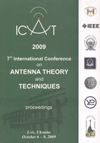EM analysis of planar electronically scanned array antennas with radiating element errors
DOI:
https://doi.org/10.1109/ICATT.2009.4435139Keywords:
AESA, radiating element, coupled analysisAbstract
The analysis of electromagnetic performances of active electronically scanned array antennas (AESA) with distorted plane errors is important to the engineering development of high-performance antennas. An coupled influencing model is developed, which describes the effect on the performances of the errors caused by the bent and bowl shape distortion in the plane element positions. The application of the model to a plane array antenna demonstrates the degradation of the sidelobe level and gain of the antenna with different distortion grades. The satisfactory analysis results provide a theoretical guidance for the engineer to determine the structural tolerance.References
LACOMME, P.; SYST, T.A.; ELANCOURT, F. New trends in airborne phased array radars. Proc. of IEEE Symp. on Phased Array Systems and Technology, 2003, p.17-22.
HOMMEL, HANS; FELDLE, HEINZ-PETER. Current status of airborne active phased array (AESA) radar systems and future trends. Proc. of 1st European Radar Conf., Netherlands, 2004, p.1449-1452.
WANG, H.S.C. Performance of phased-array antennas with mechanical errors. IEEE Trans. Aerospace and Electronic Systems, 1992, v.28, p.535-545.
CHEN, J.; ZHOU, Y. Ambiguity performance analysis of SAR with thermal mechanism errors in phased array antenna. J. Beijing University Aeronautics Astronautics, 2004, v.30, p.839-843 [in Chinese].
JIANG, W.; GUO, Y.C.; LIU, T.H. Comparison of random phasing methods for reducing beam pointing errors in phased array. IEEE Trans. Antennas Propag., 2003, v.51, p.782-787.

